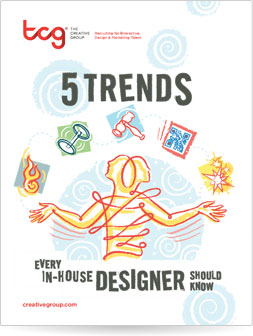Each year, The Creative Group staffing agency teams up with AIGA, the professional association for design, to find out what trends will impact creative teams in the coming years. This year, they surveyed more than 800 in-house design professionals and creative veterans from leading organizations to uncover some of the challenges that affect in-house creative teams. One area of questioning focused on the challenges of collaborating with colleagues from other departments.
Issues Affecting Collaboration
When in-house creative professionals were asked to share the biggest challenge when collaborating with colleagues in other departments, here are some their responses: “Lack of understanding of what we do and our processes.”
“Getting others to think of us as strategic partners versus pixel pushers who merely make things look good.”
“Communicating with teams composed of technical and nontechnical people.”
“Identifying the right decision makers for projects.”
“Delays in feedback and approvals.”
“Finding time to discuss plans and come up with meaningful solutions at the outset of an initiative.”
“Managing deadline and budget expectations.”
Fostering a Collaborative Corporate Culture
“Most work today requires cross-departmental collaboration, and creative teams need to take an active role in working through challenges like bridging communication gaps and juggling competing priorities,” said Diane Domeyer, executive director of The Creative Group. “Managers should set the stage for successful group interactions, but employees at all levels can take steps to break down organizational silos.”
While many barriers to effective teamwork exist, companies are making strides in developing more collaborative cultures.
- Twenty-eight percent of in-house creative professionals surveyed said they are tapped for input at the initial stages of a project all the time.
- In the next two years, 31 percent of respondents expect they will always be involved in kickoffs and interact more frequently with cross-departmental peers.
- During the next 12 months, 48 percent of in-house professionals anticipate collaborating more frequently with public relations/corporate communications departments. Another 36 percent foresee closer partnering with information technology groups.
To help organizations foster greater teamwork, The Creative Group and AIGA have published a new report, “Collaboration in the Workplace: How to Overcome 7 Common Challenges.”
The report, available at creativegroup.com/ctf, provides tips from creative leaders on building stronger and more efficient cross-departmental relationships.
About The Creative Group
The Creative Group (TCG) specializes in placing a range of highly skilled interactive, design, marketing, advertising and public relations professionals with a variety of firms on a project, contract-to-hire and full-time basis.
About AIGA
Founded in 1914, AIGA remains the oldest and largest professional membership organization for design. AIGA defines global standards and ethical practices, guides design education, inspires designers and the public, enhances professional development, and makes powerful tools and resources accessible to all.



